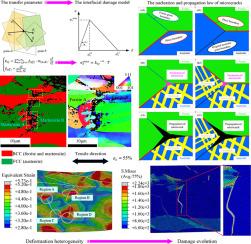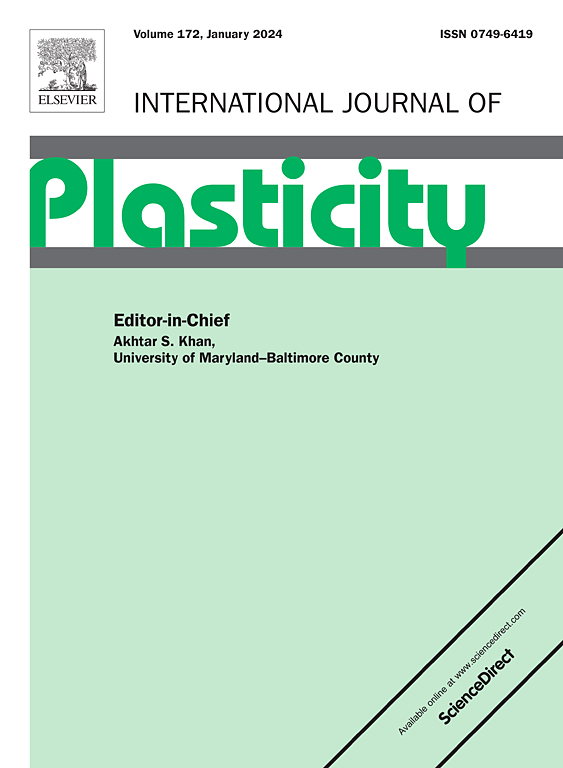The interfacial damage of the deformation heterogeneity in the transformation-induced plasticity (TRIP)-assisted duplex stainless steel
IF 9.4
1区 材料科学
Q1 ENGINEERING, MECHANICAL
引用次数: 0
Abstract
The characteristic of differences in material properties between phases gives rise to significant deformation heterogeneity in dual-phase or multi-phase materials, consequently resulting in complex damage laws. In this study, the microcracks characteristics of transformation-induced plasticity (TRIP)-assisted duplex stainless steel were observed after large deformation (engineering strain up to 55%). It has been determined that microcracks invariably occur at interface locations, including the phase boundary between original austenite and ferrite, the grain boundary of original austenite, and the grain boundary of ferrite. The deformation heterogeneity of various types of interfaces is analyzed by using crystal plasticity finite element method (CPFEM). Deformation degree coordination parameter and slip transfer parameter are established, based on the velocity gradient tensor and the slipping rate of activated slip system in CPFEM, to analyze the multi-slip heterogeneous deformation behavior of grains on both sides of the interface. A novel interfacial damage model considering the slip transfer parameter is established, which reveals the correlation between deformation heterogeneity and damage mechanism, to provide a criterion for various types of interfacial failure behaviors. The interfacial damage model based on deformation heterogeneity can stand as an invaluable instrument for exploring the damage behaviors of two-phase or multi-phase materials.


相变诱导塑性(TRIP)辅助双相不锈钢中变形不均匀的界面损伤
双相或多相材料的相变特性差异导致其变形不均匀性显著,损伤规律复杂。在本研究中,观察了变形诱导塑性(TRIP)辅助双相不锈钢在大变形(工程应变高达55%)后的微裂纹特征。结果表明,微裂纹总是发生在界面位置,包括原奥氏体与铁素体的相界、原奥氏体的晶界和铁素体的晶界。采用晶体塑性有限元法分析了不同类型界面的变形不均匀性。基于CPFEM中激活滑移体系的速度梯度张量Lp和滑移率γ˙,建立变形度协调参数kl和滑移传递参数ktf,分析界面两侧晶粒的多滑移非均质变形行为。建立了考虑滑移传递参数ktf的界面损伤模型,揭示了变形非均质性与损伤机理之间的关系,为各种类型的界面破坏行为提供了准则。基于变形非均质性的界面损伤模型是研究两相或多相材料损伤行为的重要工具。
本文章由计算机程序翻译,如有差异,请以英文原文为准。
求助全文
约1分钟内获得全文
求助全文
来源期刊

International Journal of Plasticity
工程技术-材料科学:综合
CiteScore
15.30
自引率
26.50%
发文量
256
审稿时长
46 days
期刊介绍:
International Journal of Plasticity aims to present original research encompassing all facets of plastic deformation, damage, and fracture behavior in both isotropic and anisotropic solids. This includes exploring the thermodynamics of plasticity and fracture, continuum theory, and macroscopic as well as microscopic phenomena.
Topics of interest span the plastic behavior of single crystals and polycrystalline metals, ceramics, rocks, soils, composites, nanocrystalline and microelectronics materials, shape memory alloys, ferroelectric ceramics, thin films, and polymers. Additionally, the journal covers plasticity aspects of failure and fracture mechanics. Contributions involving significant experimental, numerical, or theoretical advancements that enhance the understanding of the plastic behavior of solids are particularly valued. Papers addressing the modeling of finite nonlinear elastic deformation, bearing similarities to the modeling of plastic deformation, are also welcomed.
 求助内容:
求助内容: 应助结果提醒方式:
应助结果提醒方式:


